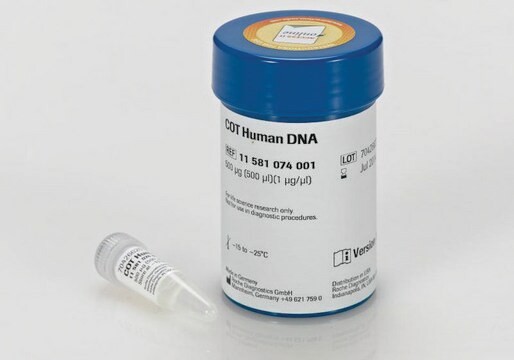Kluczowe dokumenty
05480647001
Roche
COT Human DNA, Fluorometric Grade
solution, pkg of 1 mg
Synonim(y):
COT Human DNA, DNA
About This Item
Polecane produkty
pochodzenie biologiczne
human placenta (DNA)
Poziom jakości
klasa czystości
fluorometric grade
Postać
solution
opakowanie
pkg of 1 mg
producent / nazwa handlowa
Roche
stężenie
1.0-1.5 mg/mL
zanieczyszczenia
HCV/HBV, none detected
HIV 1/2, none detected
kolor
colorless
rozpuszczalność
water: miscible
temp. przechowywania
−20°C (−15°C to −25°C)
Szukasz podobnych produktów? Odwiedź Przewodnik dotyczący porównywania produktów
Opis ogólny
Zastosowanie
- Nucleic acid labeling and detection
- DNA Microarray applications such as comparative genome hybridization and sequence capture
- Complex hybridization of human nucleic acids like FISH
Cechy i korzyści
- Improve specificity by blocking unspecific nucleic acid motifs using high concentrations of double-stranded, repetitive, human DNA.
- Achieve consistent and reliable results using fluorometrically quantified COT Human DNA, for preferentially detecting dsDNA.
- Use COT Human DNA that has been tested using DNA microarrays and comparative genome hybridization (CGH).
Jakość
For quality assessment in the CGH application, target sequences located on the X-chromosome are compared in male and female genomic DNA samples. The donor material for this product was tested for HBs antigen and for the presence of antibodies to HIV-1, HIV-2, HCV, and found to be negative.
Sekwencja
Postać fizyczna
Przechowywanie i stabilność
Inne uwagi
Kod klasy składowania
12 - Non Combustible Liquids
Klasa zagrożenia wodnego (WGK)
nwg
Temperatura zapłonu (°F)
No data available
Temperatura zapłonu (°C)
No data available
Certyfikaty analizy (CoA)
Poszukaj Certyfikaty analizy (CoA), wpisując numer partii/serii produktów. Numery serii i partii można znaleźć na etykiecie produktu po słowach „seria” lub „partia”.
Masz już ten produkt?
Dokumenty związane z niedawno zakupionymi produktami zostały zamieszczone w Bibliotece dokumentów.
Nasz zespół naukowców ma doświadczenie we wszystkich obszarach badań, w tym w naukach przyrodniczych, materiałoznawstwie, syntezie chemicznej, chromatografii, analityce i wielu innych dziedzinach.
Skontaktuj się z zespołem ds. pomocy technicznej






